#Power of Data Analytics
Explore tagged Tumblr posts
Text
Best Big Data Hadoop Course: Unlocking the Power of Data Analytics
Unlock the power of data analytics with the best Big Data Hadoop course. Gain in-depth knowledge and practical skills to harness the potential of big data. Our comprehensive training program covers all aspects of Hadoop, including data storage, processing, and analysis. Learn from industry experts who have hands-on experience in handling large-scale data projects. Discover how to leverage Hadoop's distributed computing framework to extract valuable insights and make data-driven decisions. With our cutting-edge curriculum and hands-on exercises, you'll acquire the expertise to work with big data efficiently and effectively. Take the first step towards a successful career in data analytics. Enroll in the best Big Data Hadoop course today and unlock a world of opportunities.
#Power of Data Analytics#Power of data analytics examples#Power of data analytics in business#data analytics examples#importance of data analytics#data analytics vs data analysis#why data analytics is the future of everything#data analytics vs data science#future of data analytics
0 notes
Text
youtube
#digital marketing#@desmondjohnson183#marketing strategy#DeepSeek AI#digital marketing AI#open-source AI#AI in marketing#AI-driven content creation#predictive marketing#AI chatbots#AI-powered advertising#voice search optimization#influencer marketing AI#ethical AI#data analytics#AI customer engagement#AI-powered SEO#future of digital marketing.#Youtube
3 notes
·
View notes
Text
#digital marketing#onlinemarketingtips#seo services#DeepSeek AI#digital marketing AI#open-source AI#AI in marketing#AI-driven content creation#predictive marketing#AI chatbots#AI-powered advertising#voice search optimization#influencer marketing AI#ethical AI#data analytics#AI customer engagement
3 notes
·
View notes
Text
WebGanges Technologies is a Web Design & Software Development and Digital Marketing Company. We specializes in Online and Offline Software development which are broadly classified according to customer requirements.
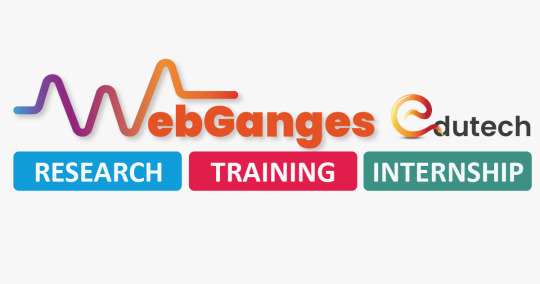
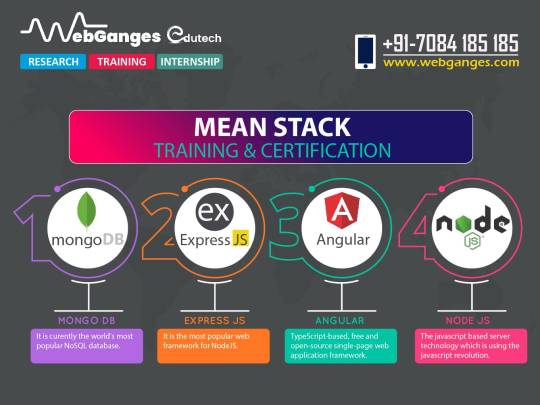
2 notes
·
View notes
Text
#artificial intelligence#business#data analytics#datascience#power bi#sql#it services#information technology
4 notes
·
View notes
Text
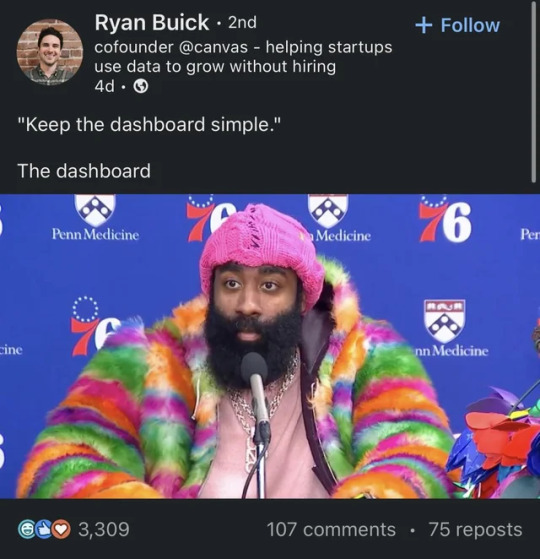
#Finance#Business#Work Meme#Work Humor#Excel#Hilarious#funny meme#funny#accounting#office humor#consulting#big data#data analysis#data visualization#data analytics#data#dashboard commentary#tableau#power bi
13 notes
·
View notes
Text
Full Stack Developer vs. Front End Developer vs. Back End Developer
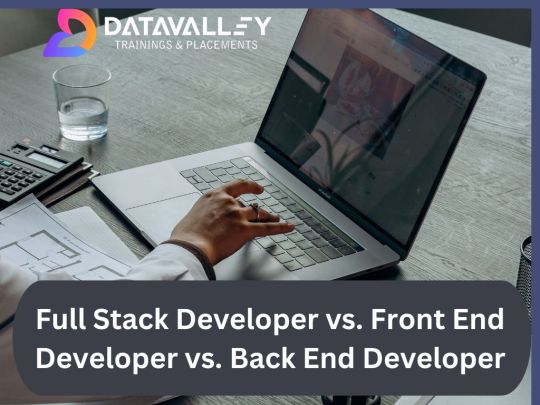
The role of a web developer is always included in the lists of high-paying IT jobs. This is because web developers are essential in today’s digital world. They create amazing websites, high-performing e-commerce sites, and other web-based applications. If you want to be a web developer, you must understand that full-stack developer skills are in great demand. However, do you understand the differences between full-stack, front-end, and back-end web development? In this post, we’ll see the differences between these three job roles, skills, and salaries.
What is Web Development?
The process of developing a website on the internet is known as web development. The non-design components of a website, such as building features and functioning with programming, markup, and scripting languages, are referred to as web development. Developers focus on technical aspects of website development such as architecture, programming, and application integration, as well as visuals.
A web developer is someone who does the following:
Creates and maintains webpages and other web-based applications.
Creates a website from a web design.
They collaborate with clients, stakeholders, and designers to understand the concept.
Can focus on frontend or backend development. Even as a full-stack developer, if necessary.
Types of Web Development
Front End Development: This aspect of web development focuses on what the user interacts with directly, i.e., the user interface of a website or web application. Front-end development deals with the design, layout, and interactivity of a site, ensuring that it’s visually appealing and user-friendly.
Back End Development: The back end is the part of a website or application that operates behind the scenes. It manages data, user authentication, and the server-side logic, ensuring the smooth functioning of the website.
Now, let’s delve into each of these roles in detail.
What is front-end development?
Front-end development, often referred to as client-side development, is the process of creating the visual elements of a website or web application that users interact with directly. It involves writing code for the user interface, optimizing website performance, and ensuring the site looks and functions correctly on various devices and browsers.
Who is a front-end developer?
A front-end developer, also known as a client-side developer, is responsible for turning web designs into a functioning website or application. They work closely with web designers and back-end developers to create an engaging and responsive user experience.
What are the front-end developer’s skills?
Front-end developers should be proficient in the following skills:
Mastery of HTML (Hypertext Markup Language) and CSS (Cascading Style Sheets) is fundamental for structuring and styling web pages.
Proficiency in JavaScript is crucial for adding interactivity and dynamic features to a website.
Knowledge of front-end frameworks like React, Angular, or Vue.js, which simplify and expedite development.
The ability to create websites that look and function well on various devices and screen sizes.
Ensuring that the website performs consistently across different browsers.
Familiarity with version control systems like Git for code management and collaboration.
Front End Developer Salary
The salary of a front-end developer can vary based on factors such as experience, location, and the company. On average, junior front-end developers can earn between $50,000 and $70,000 annually, while senior front-end developers can command salaries ranging from $90,000 to $120,000 or more.
What is Back End Development?
Back-end development, often referred to as server-side development, focuses on the server and database sides of a website or web application. It involves building and maintaining the server, databases, and applications that enable the front end to function correctly.
Who is a Back End Developer?
A back-end developer is responsible for managing the server, databases, and server-side logic of a website or application. They ensure that data is stored securely, accessed efficiently, and transmitted effectively between the front end and back end.
What are Back End Developer Skills?
Back-end developers should have expertise in the following areas:
Server-Side Programming Languages: Proficiency in languages such as Python, Ruby, Node.js, PHP, or Java is used to build server-side applications.
Databases: Knowledge of database management systems like MySQL, PostgreSQL, MongoDB, and NoSQL databases.
APIs: The ability to create and manage APIs (Application Programming Interfaces) for communication between the front end and back end.
Server Management: Skills in managing web servers and server infrastructure.
Security: Understanding web security practices and techniques to protect user data.
Version Control/Git: Proficiency in version control systems to manage and collaborate on code.
Back End Developer Salary
Back-end developer salaries can also vary based on experience, location, and the organization. Junior back-end developers can earn an annual salary ranging from $60,000 to $90,000, while senior back-end developers can expect salaries ranging from $100,000 to $150,000 or more.
Frontend vs. Backend Development
Front-end and back-end development are two halves of a whole, and they must work together seamlessly to create a functional website or application. While front-end developers focus on user interface and design, back-end developers deal with the underlying server infrastructure and data management. Both roles are essential for a successful web project.
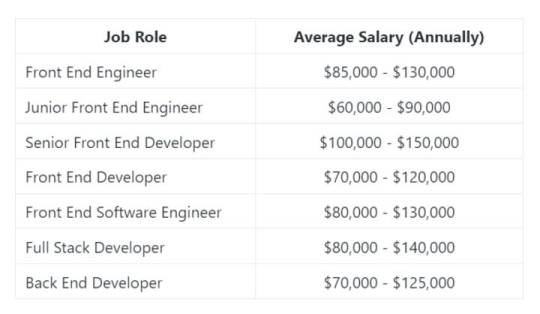
What is a Full Stack Developer?
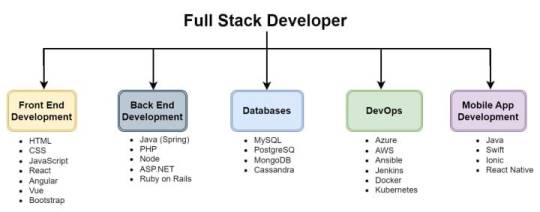
Who is a Full Stack Developer?
A full stack developer is a well-rounded professional who can take care of every aspect of web development, from designing the user interface to managing databases and server-side logic. They bridge the gap between front end and back-end development, ensuring that the entire application functions cohesively.
What are the Full Stack Developer Skills?
Full stack developers need a broad range of skills, including:
HTML/CSS: Proficiency in front end technologies for web page structuring and styling.
JavaScript: Mastery of JavaScript for creating dynamic and interactive web elements.
Front End Frameworks: Knowledge of front-end frameworks for efficient development.
Server-Side Programming Languages: Expertise in languages like Node.js, Python, Ruby, or Java for server-side development.
Databases: Proficiency in database management systems for data storage and retrieval.
APIs: Ability to create and manage APIs for communication between the front end and back end.
Version Control/Git: Familiarity with version control systems for code management.
Problem-Solving: Strong analytical and problem-solving skills to troubleshoot and optimize web applications.
Full Stack Developer Salary
Full-stack web developers are in high demand due to their range of skills and extensive knowledge. An average full stack developer’s annual salary might range from $110,000 to $150,000, based on their skill set and expertise.
Full-stack engineers earn more money than front end or back end developers. Employers agree to pay more for a full stack developer since it makes more business sense to hire one person with front and back end expertise rather than two.
As a result, the profession of a full stack developer is a profitable alternative for aspirants looking to create a career in the digital business.
The choice between becoming a full stack developer, front end developer, or back end developer depends on your interests, strengths, and career goals. Front end developers excel at creating visually appealing and user-friendly interfaces; back end developers focus on the server-side and data management; and full stack developers possess a comprehensive skill set that allows them to manage the entire development process. Each role is integral to the web development ecosystem, and the right one for you depends on your passions and aspirations within the field.
If you’re considering the path of a full stack developer and are eager to acquire the comprehensive skill set required to excel in this role, we have an excellent suggestion for you. Consider enrolling in the Full Stack Developer course at Datavalley.
Datavalley has a stellar track record of empowering aspiring developers with the knowledge and expertise to succeed in the dynamic world of web development. Their course covers everything from the fundamentals of HTML and CSS to in-depth training in JavaScript, front end and back end frameworks, and much more.
By joining Datavalley’s Full Stack Developer course, you’ll gain hands-on experience, build an impressive portfolio, and be well-prepared for a rewarding career in web development.
Don’t miss out on this opportunity to kickstart your journey as a Full Stack Developer with Datavalley. Your future in web development awaits. Take the first step today!
Attend Free Bootcamp at Datavalley
If you’re looking to supercharge your Java development skills and become a full-stack Java developer, consider joining the Java Full Stack Developer bootcamp at Datavalley. It’s an excellent opportunity to enhance your expertise and take your career to the next level.
Key points about Bootcamps:
It is completely free, and there is no obligation to complete the entire course.
20 hours total, two hours daily for two weeks.
Gain hands-on experience with tools and projects.
Explore and decide if the field or career is right for you.
Complete a mini project.
Earn a certificate to show on your profile.
No commitment is required after bootcamp.
Take another bootcamp if you are unsure about your track.
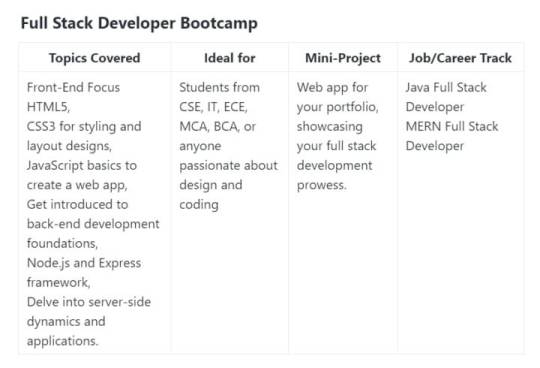
#datavalley#dataexperts#data engineering#data analytics#dataexcellence#business intelligence#data science#power bi#data analytics course#data science course#full stack course#full stack training#full stack web development#full stack developer#full stack software developer#front end developers#back end development
7 notes
·
View notes
Text

power bi course syllabus | power bi certification syllabus Boost your career with our Power BI Certification Course online. Join now for expert training and take the next step in IT success.
power bi online training india ,power bi online instructor led training ,power bi course syllabus | power bi certification syllabus ,power bi course curriculum | dax certification ,power bi certification course | dax certification course ,
#power bi online training india#power bi online instructor led training#power bi course syllabus | power bi certification syllabus#power bi course curriculum | dax certification#power bi certification course | dax certification course#sql#power bi#power bi certification cost#power bi course#msbi#data analytics#education#power bi certification#power bi online training#power bi course fees
3 notes
·
View notes
Text
DeepSeek mobility integration: From EVs to e-scooters
New Post has been published on https://thedigitalinsider.com/deepseek-mobility-integration-from-evs-to-e-scooters/
DeepSeek mobility integration: From EVs to e-scooters
DeepSeek mobility integration is spreading across China’s transport sector, with companies including automotive giants and e-scooter manufacturers incorporating AI into their products. The adoption wave began with primary electric vehicle (EV) manufacturers and has expanded recently to include the country’s leading electric two-wheeler brands.
DeepSeek’s mobility integration transforms the auto industry
According to the South China Morning Post, over the past two weeks, more than a dozen Chinese automakers have announced plans to integrate DeepSeek’s AI technology into their vehicles. The roster includes industry leader BYD, established manufacturers like Geely, Great Wall Motor, Chery Automobile, and SAIC Motor, and emerging players like Leapmotor.
BYD’s commitment to the technology is particularly noteworthy, with the company planning to integrate DeepSeek in its Xuanji vehicle software platform. The integration will let BYD offer preliminary self-driving capabilities on nearly all its models with no change to the sticker price, making autonomous driving accessible to more consumers.
The initiative covers around 20 models, including the highly-affordable Seagull hatchback, which is currently priced at 69,800 yuan (US$9,575).
E-scooter brands join the DeepSeek bandwagon
DeepSeek has hit China’s e-scooter sector most recently, as Xiaomi-backed Segway-Ninebot Group and Nasdaq-listed Niu Technologies work to incorporate AI into their electric two-wheelers.
Ninebot stated on Friday that it would “deeply integrate DeepSeek” into its products, promising enhanced features through its mobile app. The improvements are said to include AI-powered content creation, data analytics, personalised recommendations, and intelligent services to riders.
Niu Technologies claims to have integrated DeepSeek’s large language models (LLMs) as of February 9 this year. The company plans to use the technology for:
Driver assistance systems
Riding safety features
AI-powered travel companions
Voice interaction
Intelligent service recommendations
Yadea Group, the world’s largest by sales electric two-wheeler manufacturer, announced on Saturday that it plans to embed DeepSeek’s technology into its ecosystem.
The rapid adoption of DeepSeek in China’s mobility sector reflects what industry observers call “DeepSeek fever.” The technology’s appeal lies in its cost-effective and cost-efficient approach to AI integration.
The Hangzhou-based company’s open-source AI models, DeepSeek-V3 and DeepSeek-R1, operate at a fraction of the cost and computing power typically required for large language model projects.
“Cars without DeepSeek will either lose market share or be edged out of the market,” said Phate Zhang, founder of Shanghai-based EV data provider CnEVPost.
The expansion of DeepSeek mobility integration comes at a time when Chinese e-scooter brands are gaining traction in overseas markets. According to customs data, the value of electric two-wheeler exports rose 27.6% to US$5.82 billion in 2024, passing the previous peak of US$5.31 billion in 2022. Export volume increased by 47% to 22.13 million units.
Research firm IDC notes that DeepSeek’s open-source model has fostered a collaborative innovation ecosystem via platforms like GitHub, letting developers participate in optimisation and security testing.
The collaborative approach is expected to improve companies’ ability to deploy, train, and utilise large language models.
The impact of DeepSeek mobility integration on China’s transport sector appears to be growing. Zhang Yongwei, general secretary of China EV100, projects that by 2025, approximately 15 million cars – representing two-thirds of national sales – will be equipped with preliminary autonomous driving systems, underscoring the transformative potential of the technology in reshaping China’s transport system.
(Photo by Kenny Leys)
See also: DeepSeek ban? China data transfer boosts security concerns
Want to learn more about AI and big data from industry leaders? Check out AI & Big Data Expo taking place in Amsterdam, California, and London. The comprehensive event is co-located with other leading events including Intelligent Automation Conference, BlockX, Digital Transformation Week, and Cyber Security & Cloud Expo.
Explore other upcoming enterprise technology events and webinars powered by TechForge here.
#2022#2024#2025#adoption#ai#ai & big data expo#AI integration#AI models#AI technology#AI-powered#amp#Analytics#app#approach#Artificial Intelligence#automation#automotive#autonomous#autonomous driving#ban#Big Data#billion#brands#california#Cars#change#China#Cloud#collaborative#Companies
0 notes
Text
Are Marketers Under Pressure? The AI Revolution and ROI Demands
Hey did you hear marketers are now under a lot of pressure? Are you wondering why? It’s because of AI, yeah you heard me right it's AI! As it revved up the technological sector it is doing to marketing sector the same. Because of AI everyone is asking marketers to show tangible results for every penny spent on marketing channels.
Today, businesses expect to achieve greater results while spending less money, and AI is making this possible. However, in the realm of marketing, this trend can present challenges, as a limited budget often means fewer options and a greater need for niche, detailed budget preparation strategies. This blog explores the challenges and opportunities that modern digital marketers face, the role of AI in this landscape, and how professionals can adapt to stay ahead in this ever-evolving field.
Increasing ROI expectations
More than ever, businesses are examining their marketing expenses to achieve quantifiable and quick outcomes. Marketing teams are under constant pressure to increase conversions, produce leads, and guarantee a good return on investment.

Why are businesses focusing more on ROIs?
We are currently experiencing a period of economic uncertainty. In light of the recent recession, businesses are emphasizing return on investment (ROI) for each marketing channel. They are looking to reduce budgets and require justification for the potential ROI they can expect from each marketing channel.
Example: Let's say Google Ads is generating 30 leads per month, with a budget of 60000 invested each month. The marketer needs to calculate how much business these 30 leads are bringing to the company so that they can determine whether to continue investing in this marketing channel.
As AI technologies rapidly advance, companies expect AI to be involved in the decision-making process by monitoring performance with precise tracking.
Brands need to outpace competitors and prove their marketing strategies drive actual business growth.
Investors and executives demand transparency and accountability in spending.
How ROI expectations are impacting marketing strategies?
To meet rising ROI expectations, marketing teams must adopt a more analytical and results-oriented approach.
A greater emphasis is on performance metrics like conversion rate, customer acquisition rate, click-through rates, customer life value, and return on ads spent.
Today marketing is driven by data. Marketers need to utilize machine learning to gain deeper insights into consumer behavior. Some analytical tools like Google Analytics, Hubspot, and Tableau can help you track every aspect.
Hyper-personalized campaigns utilizing client segmentation, behavioral targeting, and AI-driven suggestions are replacing generalized marketing initiatives.
Today businesses are focusing on performance marketing where the payment is based on actual results.
Businesses are reducing spending on ineffective channels and reallocating funds to high-performing ones.
Rapid Technological Advancements
Automation tools, AI, and machine learning are quickly changing the sector. Although there are many advantages to modern technology, marketers face difficulties as they must constantly learn, adjust, and incorporate new tools into their plans. In a future driven by AI, marketers who don't stay up run the risk of becoming obsolete.
The Impact Of AI and Automation in Marketing
AI enables marketers to understand customer needs an deliver hyper-personalized content that resonates with them. For example Netflix.
With the vast amount of data available, AI and ML assist marketers in analyzing this data to predict market trends, customer preferences, and market demand. They also help optimize ads by segmenting high-performing audiences and improving lead scoring.
Automation in marketing enables marketers to focus on data-driven marketing decisions while AI works on repetitive tasks like scheduling posts on social media channels, AI-powered PPC management, and AI-copywriting.
Data Overload and analysis paralysis
More data is now available to marketers than ever before due to the proliferation of digital platforms. However, it can be quite difficult to organize and comprehend this enormous volume of data. Not all marketers have the advanced skills needed to comprehend consumer behavior, optimize campaigns, and make decisions in real time based on data analytics.
The Explosion of Marketing Data
Marketing channels have expanded and evolved, allowing businesses to connect with their audience through multiple platforms. However, this growth has also created a significant challenge: the vast amount of data generated across these omnichannel markets. Managing, analyzing, and deriving actionable insights from this extensive information has become increasingly difficult.
With so many data points at their disposal, marketers frequently find it difficult to prioritize, which may result in data overload and, in the worst situations, analysis paralysis—a condition in which too much data causes decision-making to stall.
Why DO Marketers Often Struggle With Data-Paralysis?
Lack of data interpretation skills, not every marketer is skilled in statistical modeling, data analytics, or AI-driven insights. Without the right instruction, it becomes challenging to identify meaningful trends, optimize campaigns, and to anticipate customer behavior.
Marketers often track too many KPIs leading to confusion.
Different platforms provide different metrics, and sometimes, data does not align across channels. For example: Google Analytics might show different website traffic than Facebook Ads Manager.
Businesses want marketers to make quick decisions based on data when using AI-driven solutions. However, many marketers lack the sophisticated tools and knowledge needed for real-time analysis.
Evolving Consumer Expectations In The Digital Age
Consumers of today expect smooth interactions across several touchpoints, immediate responses, and personalized experiences. Predictive analytics, hyper-targeted advertisements, and AI-powered chatbots have raised the bar. Marketers need to come up with creative ways to interact with consumers without going overboard.
What Do Modern Consumers Expect?
Customers communicate with brands via a variety of channels, such as websites, social media, mobile applications, email, and in-store visits. Across all of these mediums, they anticipate a cohesive and consistent experience.
Customers expect immediate answers 24/7. Speed is everything in improving customer satisfaction when resolving any issues.
Customers value ethical data use and privacy in addition to individualized experiences. Companies need to reconcile hyper-targeted advertising with avoiding giving consumers the impression that they are being tracked online.
How Have These Expectations Evolved?
AI & Predictive Analytics → Consumers now expect brands to anticipate their needs based on past behavior.
Hyper-Personalized Ads → Targeted advertising on platforms like Google and Facebook has conditioned users to expect relevant recommendations.
E-commerce Giants → Brands like Amazon, Netflix, and Spotify have set high standards for seamless, AI-driven user experiences.
The Digital-First Economy → More consumers prefer online shopping, digital payments, and virtual customer service.
Thriving Amidst AI and ROI Demands: Embracing the Future of Marketing
There is no denying that marketers are under pressure due to the AI revolution and rising ROI demands. AI is a strong ally that, when applied properly, can boost productivity and improve marketing initiatives; it is not the adversary. The secret is striking a balance between human creativity, morality, strategic thinking, and AI-powered automation.
Those who embrace AI while developing their special talents will prosper in this cutthroat environment as marketing continues to change. The ability to successfully manage the AI revolution while preserving the fundamentals of narrative and genuine brand interaction will determine the direction of marketing in the future.
0 notes
Text
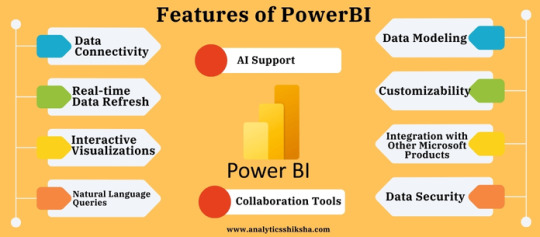
Power BI has many features to help with analyzing and visualising data in the format chosen by the user. Here are some of the key features of Power BI:
Data Connectivity: Using Power BI it is possible to connect to a wide range of data sources, including cloud services and local databases.
Real-time Data Refresh: It provides features for refreshing the data in real time.
Interactive Visualizations: The software allows users to create and share interactive and immersive reports and dashboards with multiple visualizations.
Natural Language Queries: Another capability being offered to business users is the natural language queries through which users can ask questions and get responses in form of charts and graphs.
Data Modeling: It has comprehensive data modeling capabilities that support the handling of large amounts of data and provides tools to change the data when necessary.
Customizability: Power BI provides users with a flexible option to design the layout of the dashboard or a report according to the organization needs.
Integration with Other Microsoft Products: It is well aligned with other Microsoft business apps like Microsoft Azure and Office 365 for the interoperation of data.
Data Security: Possesses strong security measures at various tiers, including the option to regulate data’s accessibility and use.
AI Support: Azure AI is integrated with Power BI to provide users with direction within data to make better decisions.
Collaboration Tools: Provides options for sharing and publishing of dashboards and reports through the Power BI service. Learn More:-https://www.analyticsshiksha.com/blog/what-is-power-bi-data-analysis-features-uses-benefits
#Natural Language Queries#Collaboration Tools#Data Security:#Microsoft Products#Data Connectivity:#Power BI#data analytics courses in delhi#data analytics courses
0 notes
Text
0 notes
Text
How a Data Analyst Course Can Change Your Future
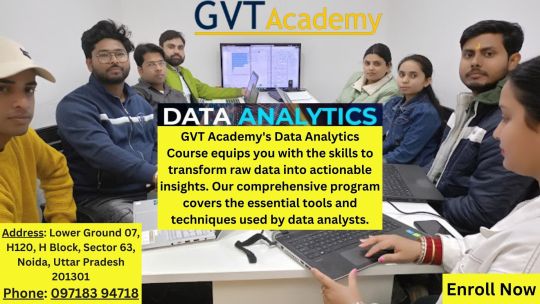
In the age of technology, data is what drives business decisions. Companies will rely on analysts to interpret intricate information, trend analysis, and make informed decisions. If you are looking for a career that has high demand, excellent growth prospects, and competitive salaries, then a GVT Academy Best Data Analyst Course can be the stepping stone towards success.
Why Choose a Career in Data Analytics?
High Demand & Job Security: All sectors, be it finance, healthcare, retail, or IT, are looking for trained data analysts. With the growing need for data-driven decision-making, this is a long-term career security job.
Lucrative Salary Packages: Data analysts earn good salaries. The entry-level professionals can fetch a decent package, and the experienced analysts earn six-figure incomes.
Versatile Career Options: data analyst's work is not restricted to IT; it can be found in the banking, marketing, e-commerce, health care, and even sports analytics field. The possibilities are endless!
Skill-Based Career Growth: Data analytics is unlike other jobs, which require experience in years, but it mainly focuses on skills. If one has the appropriate knowledge and tools, he can quickly climb up the corporate ladder.
What Do You Learn in a Data Analyst Course?
Data Visualization & Reporting (Excel, Power BI,) Data Cleaning & Processing (SQL, Python,) Statistical Analysis & Predictive Modeling Machine Learning Basics for Data Analytics Business Intelligence & Decision-Making
Why Choose GVT Academy for Your Data Analyst Training?
✔ Training from Experts – Learn from experts with real-world experience. ✔ Hands-on Projects – Gain practical exposure through real data sets. ✔ Placement Assistance – Get support in job placements and resume building. ✔ Affordable Fees & Flexible Batches – Study at your convenience.
Your Future Starts Today!
If you want to build a rewarding career in data analytics, now is the time to start! Enroll in our Data Analyst Course at GVT Academy and take charge of your future.
Call us now: [9718394718] Visit us: [gvtacademy.com]
Email: [email protected]
Connect with us via social media:
Facebook: www.facebook.com/gvtacademy
Instagram: www.instagram.com/gvtacademy
X (formerly twitter): x.com/GVTAcademy
Google My Business: https://g.co/kgs/v3LrzxE
0 notes
Text
Kreate Technologies offers AI, ERP, GIS, EV Mobility, Data Analytics, and Demand load forecasting solutions. To Transform your business with technology experts.
#AI-Powered Energy Load Forecasting#AI#ERP#GIS#EV Mobility#Data Analytics#IT Services for Renewable Energy GCC#IT Solutions Provider in India
1 note
·
View note
Text
The Future of Full Stack Java Development
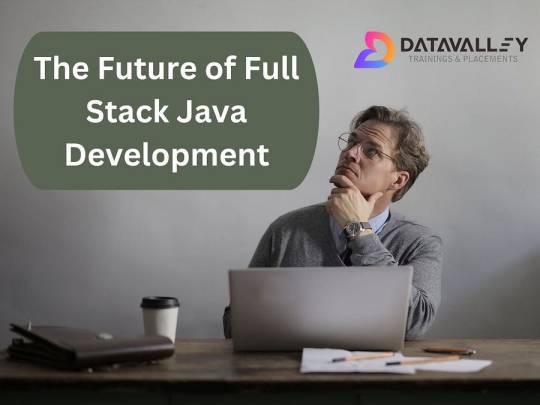
Full-stack developers, also known as “jack of all trades,” are in high demand in India. They are capable of carrying out the duties of numerous professionals. They earn good money and have many job opportunities with rewarding experiences because of their diverse skills. Full-stack Java programming has a bright future because its popularity is growing and will continue to grow in the coming years.
It’s well known that full-stack developers are proficient in both server-side and client-side programming. They are the professionals who carry out the responsibilities of backend and frontend developers. Despite not always being regarded as specialists, their abilities enable them to handle development tasks with ease. All firms look forward to having a brilliant full-stack developer as a future developer for a number of reasons. They handle a variety of technologies, which enables them to manage more project facets than the typical coder.
An experienced web developer who primarily works with Java programming is known as a Java full-stack developer. The front end, back end, and database layer are the three levels of code that these web developers build. The web development teams are frequently led by full-stack Java engineers, who also assist in updating and designing new websites. Because there is a great demand for Java full-stack developers. Many institutions have seized the opportunity by providing well-thought-out Java full-stack developer courses. You may study full-stack development quickly and become an expert in the area with the aid of these courses.
Java Full Stack Development by Datavalley
100% Placement Assistance
Duration: 3 Months (500+ hours)
Mode: Online/Offline
Let’s look into the future opportunities for full-stack Java professionals in India.
4 things that will Expand the Future Purpose of Java Full-Stack Developers
The Role of a Full-Stack Developer
Full-stack developers work on numerous tasks at once. They need to be extremely talented and knowledgeable in both front-end and back-end programming languages for this. JavaScript, CSS, HTML, and other frontend programming languages are essential. When creating new websites or modifying old ones, Java is a key programming language used by Java full-stack developers. However, backend programming languages consist of .Net, PHP, and Python depending on the projects. The full stack developers are distinguished from other developers by their proficiency and understanding of programming languages. With the availability of the finest Java full stack developer training, students may now easily master a frontend programming language like Java. The full-stack developer is more valuable and in demand when they are knowledgeable in multiple programming languages.
Responsibilities of a Full-Stack Developer
Functional databases are developed by full-stack developers. It creates aesthetically pleasing frontend designs that improve user experience and support the backend. The entire web-to-web architecture is under the control of these full-stack developers. They are also in charge of consistently maintaining and updating the software as needed. The full-stack developers bear the responsibility of overseeing a software project from its inception to its finalized product.
In the end, these full-stack developers also satisfy client and technical needs. Therefore, having a single, adaptable person do many tasks puts them in high demand and increases their potential for success in the technology field. Through extensively developed modules that expand their future scope, the Java full-stack developer course equips students with the skills necessary to take on these tasks.
The full-stack developer salary range
Full-stack developers are among the highest-paid workers in the software industry. In India, the average salary for a full-stack developer is 9.5 lakhs per annum. The elements that determine income typically include experience, location of the position, company strength, and other considerations. A highly skilled and adaptable full-stack developer makes between 16 and 20 lakhs per annum. Full-stack engineers get paid a lot because of their extensive skills, they can handle the tasks of two or three other developers at once.
By fostering the growth of small teams, preventing misunderstandings, and cutting the brand’s operating expenses, these full-stack developers perform remarkable work. Students who take the Java full-stack developer course are better equipped to become versatile full-stack developers, which will increase their demand currently as well as in the future in the industry.
Job Opportunities of Java Full Stack Developers
The full-stack developers are knowledgeable professionals with a wide range of technological skills. These competent workers are conversant with numerous stacks, including MEAN and LAMP, and are capable of handling more tasks than a typical developer. They are skilled experts with a wealth of opportunities due to their extensive understanding of several programming languages.
Full-stack developers are in high demand because they can work on a variety of projects and meet the needs of many companies. The full-stack Java developer course helps students build this adaptability so they can eventually become the first choice for brands searching for high-end developers.
As a result, these are a few key factors improving the future prospects of Java Full Stack developers in India. They are vibrant professionals who are in high demand due to their diverse skill set and experience, and they are growing steadily. The Java full stack developer course can help students hone their knowledge and abilities to succeed in this industry.
Datavalley’s Full Stack Java Developer course can help you start a promising career in full stack development. Enroll today to gain the expertise and knowledge you need to succeed.
Attend Free Bootcamps
Looking to supercharge your Java skills and become a full-stack Java developer? Look no further than Datavalley’s Java Full Stack Developer bootcamp. This is your chance to take your career to the next level by enhancing your expertise.
Key points about Bootcamps:
It is completely free, and there is no obligation to complete the entire course.
20 hours total, two hours daily for two weeks.
Gain hands-on experience with tools and projects.
Explore and decide if the field or career is right for you.
Complete a mini-project.
Earn a certificate to show on your profile.
No commitment is required after bootcamp.
Take another bootcamp if you are unsure about your track.

#dataexperts#datavalley#data engineering#data analytics#dataexcellence#business intelligence#data science#power bi#data analytics course#data science course#java developers#java full stack bootcamp#java full stack training#java full stack course#java full stack developer
2 notes
·
View notes
Text
power bi course curriculum | dax certification Boost your career with our Power BI Certification Course online. Join now for expert training and take the next step in IT success.
power bi online training india , power bi online instructor led training , power bi course syllabus | power bi certification syllabus , power bi course curriculum | dax certification , power bi certification course | dax certification course
#power bi online training india#power bi online instructor led training#power bi course syllabus | power bi certification syllabus#power bi course curriculum | dax certification#power bi certification course | dax certification course#data analytics#education#power bi#power bi certification#sql#power bi certification cost#msbi#power bi course fees#power bi online training#power bi course
2 notes
·
View notes